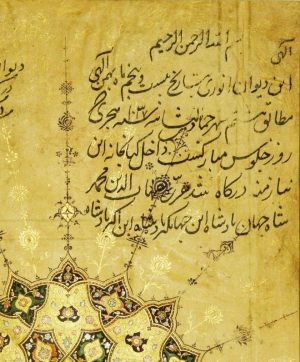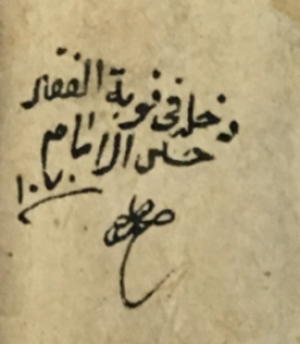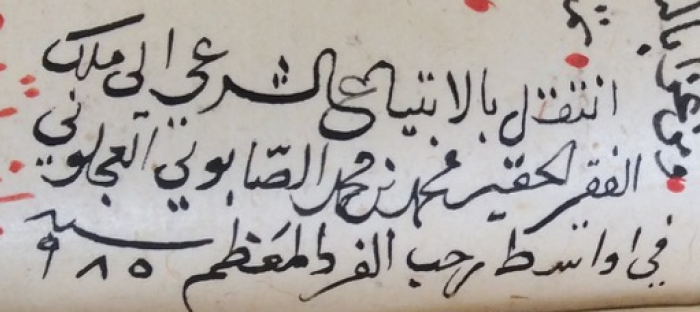About this manuscript
In the viewer is a copy of the famous Shāhnāma or the Book of Kings, composed by the Persian poet Firdawsi (d. ca 1020). This specific copy was commissioned by the Timurid prince Muhammad Juki (1402-1445) in Herat and was brought to India by the founder of the Mughal empire, Bābur (r. 1526-1530). The manuscript (Cambridge, MS RAS 239) belongs to the Royal Asiatic Society of Cambridge University. This lesson is about the trove of information on f 3recto, which contains one ownership note and five seals of consecutive owners.
Gilding
The emperors' seals are dispersed on a sheet that was gilded to provide space for the main note of ownership, by Shāhjahān. This gilding covered some earlier notes which are now invisible. But it was carefully applied around the seals of Bābur, Humāyūn (r. 1530-1556), Akbar (r. 1556-1605) and Jahāngīr (r. 1605-1627) that were there before. (The open space of the letters in these seals shows paper, not gilding.) The seals of the emperors Shāhjahān (r. 1628-1658) and Aurangzeb (r. 1656-1717) were later stamped onto the gilding.
It was common in the Mughal tradition to write ownership notes not on the first folium of a codex, but on a separate folium that was then inserted in a codex. The gilded leaf was originally also a separate leaf, but was later trimmed and pasted onto the first folium of this codex.
Seals
The seal in the upper left corner is that of Bābur. The text is ظهیر الدین محمد بابر بن سلطان عمر شیخ گورکان بهادر .
To its right is the seal of Bābur’s son Humāyūn, with the text همایون بن محمد بابرپادشاه غازی .
The round seal beneath it is of Jahāngīr and says هانگیر شاه اکبر شاه
The drop-shaped seal of Shāhjahān صاحب قران ثانی شهاب الدین محمد شاه جهان پادشاه غازی.
To the left a small part of a round seal survived that belonged to Akbar and may have read جلال الدین محمد اکبر بن همایون.
So this codex was first inherited from Bābur by his son Humayun, then by Akbar, then by his son Jahāngir, who passed it on to his son Shāhjahān.
Beneath the words واول دویم صحی are traces of a round seal that has been erased.
Notes
Between the seals of Bābur and Humāyūn we find the words واول دویم صحی (class one, grade two, correct). They classify the manuscript and may have been written by the Mughal librarian. There are traces of text above the three words as well as on the left of the sheet. These notes were lost when the sheet was trimmed. Finally, the word in the upper right corner is important: it says خاصة, that is: special/selected, suggesting the importance of this manuscript.
From other manuscripts that carry an ownership note by Shāhjahān, we know that he usually followed the wording of his father’s tamalluk, and wrote his own note next to his father’s (to its left or below it). Therefore, this Shāhnāma may also have carried Jahāngīr’s note.
Books and power
Now let’s look at the written statement of ownership by Shāhjahān. It reads:
بسم الله الرحمن الرحیم
آلهی
این شاهنامه بتاریخ ۲۵ ماه بهمن آلهی
مطابق هشتم شهر جمادی الثانیه سنه ۱۰۳۷ هجری که روز
جلوس مبارکست داخل کتابخانه این
نیازمند درگاه شد حرره شهاب الدین محمد شاه جهان
پادشاه ابن جهانگیر پادشاه ابن اکبر پادشاه غازی
In the name of God, the Compassionate, the Merciful
O God (or Divine)
This Shāhnāma
on the 25th of the divine month of Bahman,
corresponding to the eighth of Jamādi al-thānī year 1037 which is
the blessed day of accession was deposited to the library of this
suppliant [to God]. Written by the king Shihāb al-Dīn Muḥammad
Shāhjahān, son of the king Jahāngir, son of the king Akbar the conqueror.

The date mentioned on this “very special” codex recurs in ownership notes by emperor Shāhjahān in other manuscripts as well. For instance, his note on a copy of the Divān-i Anvarī (BN supp. Pers. 514) a collection of poems by the Persian poet Anvari (d. 1189), on Nizāmī’s Khamsa (BL Or. 6810), and on a copy of Jami’s Tuḥfat al-abrār (BN Supp. Pers. 1416) and some other manuscripts is practically the same.
The 25th of the month of Bahman in the year 1037H/1628CE was the date of Shahjahan’s accession to the throne. It was on this day that the books existed in the imperial library (kitabkhāna) received Shāhjahān’s mark, and became Shāhjahān’s property. And perhaps they were brought from the library of his father to his own library on that day. In any case, the notes show that Shāhjahān saw these books (and many others) one by one and wrote his tamalluk note on them on that precise day. If this assumption is correct then these notes reveal significant and new information for our understanding of the early Mughal history: that taking possession of the previous emperor’s library was part of the ceremony of accession to the throne. (Said Reza Huseini is preparing an article on the subject.)
Assignments
-
The Mughal tamalluk notes, accompanied by emperors' personal seals, testify of the importance the emperors attached to these books. The question remains, however, what an emperor's personal relation with such a book was. Examine the manuscript in the viewer to see what traces you find that could help answer that question.


